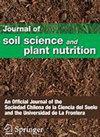钾和钾纳米胶囊对高温胁迫下辣椒生长及生理变化的影响
IF 3.1
3区 农林科学
引用次数: 0
摘要
非生物胁迫已被观察到引起植物形态、生理和生物化学的改变。然而,近年来,利用纳米化合物已经成为一种诱导植物生物学多个方面的修饰的策略。这些修饰包括植物生长、养分吸收、重要次生代谢物的产生以及植物对非生物和生物胁迫因子抗性的提高。建立一个完全随机的12个重复的析因实验。钾源包括对照、钾(K)和浓度为1µM的纳米胶囊钾(N-K),温度处理包括控制温度(25°C)和高温应激(35°C)。在对照处理中,脯氨酸在高温下增加,而K和N-K处理温度下脯氨酸均减少。高温使电解质泄漏(EL)升高,在对照处理时达到峰值,但K和N-K降低了EL。当温度为35℃时,对照和K处理的葡萄糖和果糖均呈温度依赖性增加,但35℃时不同K水平之间无显著差异。高温不施K时,抗氧化活性(DPPH)和丙二醛(MDA)等主要胁迫指标显著升高,水势和亚油酸也显著升高。高温处理下,纳米胶囊钾的胁迫指数最低。综上所述,在高温下施用纳米钾胶囊,应力指标降低。此外,在辣椒生长和抗性指标上,高温施钾纳米胶囊优于高温施钾。同样,纳米胶囊钾在高温下的应用改变了膜和抗氧化酶的脂肪酸组成。本文章由计算机程序翻译,如有差异,请以英文原文为准。
Effects of Potassium and Nanocapsule of Potassium on Pepper Growth and Physiological Changes in High-Temperature Stress
Abstract Abiotic stresses have been observed to cause alterations in the morphology, physiology, and biochemistry of plants. However, in recent years, the utilization of nanocompounds has emerged as a strategy to induce modifications in multiple facets of plant biology. These modifications include plant growth, nutrient absorption, the production of significant secondary metabolites, and the improvement of plants’ resistance against both abiotic and biotic stress factors. A completely randomized factorial experiment with 12 replications was created. Potassium sources including control, potassium (K), and nanocapsule-potassium (N-K) with concentration 1 µM and temperature treatments including control temperature (25 °C) and high-temperature stress (35 °C) were applied as treatments. In the control treatment, proline was increased at the high temperature, whereas proline was reduced at both treated temperatures by K and N-K. High temperature raised electrolyte leakage (EL), which peaked in the control treatment but was lowered by K and N-K. Temperature-dependent increase in glucose and fructose was observed in control and K treatments when the temperature was 35 °C, but no significant difference was observed between different levels of K at 35 °C. When K was not applied at high temperatures, the main stress indicators such as antioxidant activity (DPPH) and malondialdehyde (MDA) rose significantly, as did the water potential and linoleic acid. When high temperatures were applied, nanocapsule-potassium applied in high temperatures had the lowest stress indices. In conclusion, stress indices diminish when nanocapsule-potassium is applied under high temperatures. Additionally, nanocapsule-potassium applied at high temperatures was preferable to K applied at high temperatures in terms of pepper growth and resistance measures. Likewise, the application of nanocapsule-potassium at high temperatures alters the fatty acid composition of membranes and antioxidant enzymes.
求助全文
通过发布文献求助,成功后即可免费获取论文全文。
去求助
来源期刊

Journal of Soil Science and Plant Nutrition
SOIL SCIENCE-
自引率
10.30%
发文量
331
期刊介绍:
The Journal of Soil Science and Plant Nutrition is an international, peer reviewed journal devoted to publishing original research findings in the areas of soil science, plant nutrition, agriculture and environmental science.
Soil sciences submissions may cover physics, chemistry, biology, microbiology, mineralogy, ecology, pedology, soil classification and amelioration.
Plant nutrition and agriculture submissions may include plant production, physiology and metabolism of plants, plant ecology, diversity and sustainability of agricultural systems, organic and inorganic fertilization in relation to their impact on yields, quality of plants and ecological systems, and agroecosystems studies.
Submissions covering soil degradation, environmental pollution, nature conservation, and environmental protection are also welcome.
The journal considers for publication original research articles, technical notes, short communication, and reviews (both voluntary and by invitation), and letters to the editor.
 求助内容:
求助内容: 应助结果提醒方式:
应助结果提醒方式:


